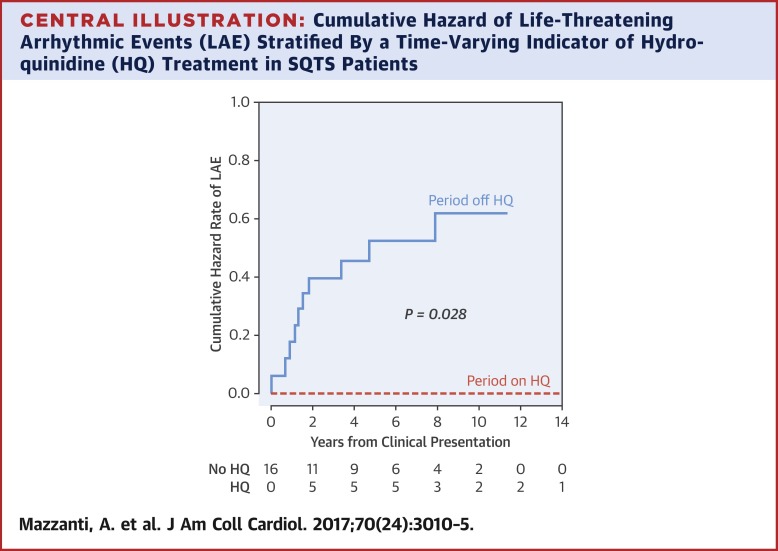当前位置:
X-MOL 学术
›
J. Am. Coll. Cardiol.
›
论文详情
Our official English website, www.x-mol.net, welcomes your
feedback! (Note: you will need to create a separate account there.)
Hydroquinidine Prevents Life-Threatening Arrhythmic Events in Patients With Short QT Syndrome
Journal of the American College of Cardiology ( IF 21.7 ) Pub Date : 2017-12-01 , DOI: 10.1016/j.jacc.2017.10.025 Andrea Mazzanti , Riccardo Maragna , Gaetano Vacanti , Anna Kostopoulou , Maira Marino , Nicola Monteforte , Raffaella Bloise , Katherine Underwood , Valentina Tibollo , Eleonora Pagan , Carlo Napolitano , Riccardo Bellazzi , Vincenzo Bagnardi , Silvia G. Priori
Journal of the American College of Cardiology ( IF 21.7 ) Pub Date : 2017-12-01 , DOI: 10.1016/j.jacc.2017.10.025 Andrea Mazzanti , Riccardo Maragna , Gaetano Vacanti , Anna Kostopoulou , Maira Marino , Nicola Monteforte , Raffaella Bloise , Katherine Underwood , Valentina Tibollo , Eleonora Pagan , Carlo Napolitano , Riccardo Bellazzi , Vincenzo Bagnardi , Silvia G. Priori

|
BACKGROUND
Short QT syndrome (SQTS) is a rare and life-threatening arrhythmogenic syndrome characterized by abbreviated repolarization. Hydroquinidine (HQ) prolongs the QT interval in SQTS patients, although whether it reduces cardiac events is currently unknown. OBJECTIVES
This study investigated whether long-term treatment with HQ reduces the occurrence of life-threatening arrhythmic events (LAE) (cardiac arrest or sudden cardiac death) in SQTS patients. METHODS
In this cohort study on consecutive SQTS patients, 2 analyses were performed: 1) a matched-period analysis for the occurrence of LAE in 17 SQTS patients who received long-term HQ; and 2) a comparison of the annual incidence of LAE off- and on-HQ in 16 SQTS patients who survived a cardiac arrest. RESULTS
A total of 17 patients (82% male, age 29 ± 3 years, QTc before treatment 331 ± 3 ms) received HQ therapy (584 ± 53 mg/day). Therapy was stopped in 2 cases (12%) due to gastrointestinal intolerance, and 15 patients continued treatment for 6 ± 1 year. QTc prolongation was observed in all patients (by 60 ± 6 ms; p < 0.001). We compared the occurrence of LAE during 6 ± 1 years before and after HQ, observing that patients on HQ experienced a reduction in both the rate of LAE from 40% to 0% (p = 0.03) and the number of LAE per patient from 0.73 ± 0.3 to 0 (p = 0.026). Furthermore, the annual rate of LAE in the 16 patients with a previous cardiac arrest dropped from 12% before HQ to 0 on therapy (p = 0.028). CONCLUSIONS
We demonstrated for the first time that treatment with HQ was associated with a lower incidence of LAE in SQTS patients. These data point to the importance that quinidine, that in several countries has been removed from the market, remains available worldwide for patients with SQTS. In the present study, therapy with HQ has been proven to be safe, with a relatively low rate of side effects.
中文翻译:

氢奎尼丁可预防短 QT 综合征患者危及生命的心律失常事件
背景短 QT 综合征 (SQTS) 是一种罕见且危及生命的致心律失常综合征,其特征是短暂的复极。氢奎尼丁 (HQ) 可延长 SQTS 患者的 QT 间期,但目前尚不清楚它是否能减少心脏事件。目的 本研究调查了长期使用 HQ 治疗是否能减少 SQTS 患者危及生命的心律失常事件 (LAE)(心脏骤停或心源性猝死)的发生。方法 在这项针对连续 SQTS 患者的队列研究中,进行了 2 项分析:1) 17 名接受长期 HQ 的 SQTS 患者发生 LAE 的匹配期分析;2) 比较 16 名心脏骤停幸存的 SQTS 患者在总部外和总部内 LAE 的年发生率。结果 共有 17 名患者(82% 男性,年龄 29 ± 3 岁,QTc 治疗前 331 ± 3 ms)接受 HQ 治疗(584 ± 53 mg/天)。2例(12%)因胃肠道不耐受停止治疗,15例继续治疗6±1年。在所有患者中均观察到 QTc 延长(60 ± 6 ms;p < 0.001)。我们比较了 HQ 前后 6 ± 1 年内 LAE 的发生率,观察到 HQ 患者的 LAE 发生率从 40% 降至 0% (p = 0.03) 和每位患者的 LAE 数量从 0.73 ± 0.3 到 0 (p = 0.026)。此外,16 名既往心脏骤停患者的 LAE 年发生率从 HQ 前的 12% 降至治疗后的 0 (p = 0.028)。结论 我们首次证明,在 SQTS 患者中,使用 HQ 治疗与较低的 LAE 发生率相关。这些数据表明奎尼丁的重要性,已在多个国家/地区从市场上移除,但在全球范围内仍可用于 SQTS 患者。在本研究中,HQ 治疗已被证明是安全的,副作用发生率相对较低。
更新日期:2017-12-01
中文翻译:

氢奎尼丁可预防短 QT 综合征患者危及生命的心律失常事件
背景短 QT 综合征 (SQTS) 是一种罕见且危及生命的致心律失常综合征,其特征是短暂的复极。氢奎尼丁 (HQ) 可延长 SQTS 患者的 QT 间期,但目前尚不清楚它是否能减少心脏事件。目的 本研究调查了长期使用 HQ 治疗是否能减少 SQTS 患者危及生命的心律失常事件 (LAE)(心脏骤停或心源性猝死)的发生。方法 在这项针对连续 SQTS 患者的队列研究中,进行了 2 项分析:1) 17 名接受长期 HQ 的 SQTS 患者发生 LAE 的匹配期分析;2) 比较 16 名心脏骤停幸存的 SQTS 患者在总部外和总部内 LAE 的年发生率。结果 共有 17 名患者(82% 男性,年龄 29 ± 3 岁,QTc 治疗前 331 ± 3 ms)接受 HQ 治疗(584 ± 53 mg/天)。2例(12%)因胃肠道不耐受停止治疗,15例继续治疗6±1年。在所有患者中均观察到 QTc 延长(60 ± 6 ms;p < 0.001)。我们比较了 HQ 前后 6 ± 1 年内 LAE 的发生率,观察到 HQ 患者的 LAE 发生率从 40% 降至 0% (p = 0.03) 和每位患者的 LAE 数量从 0.73 ± 0.3 到 0 (p = 0.026)。此外,16 名既往心脏骤停患者的 LAE 年发生率从 HQ 前的 12% 降至治疗后的 0 (p = 0.028)。结论 我们首次证明,在 SQTS 患者中,使用 HQ 治疗与较低的 LAE 发生率相关。这些数据表明奎尼丁的重要性,已在多个国家/地区从市场上移除,但在全球范围内仍可用于 SQTS 患者。在本研究中,HQ 治疗已被证明是安全的,副作用发生率相对较低。











































 京公网安备 11010802027423号
京公网安备 11010802027423号